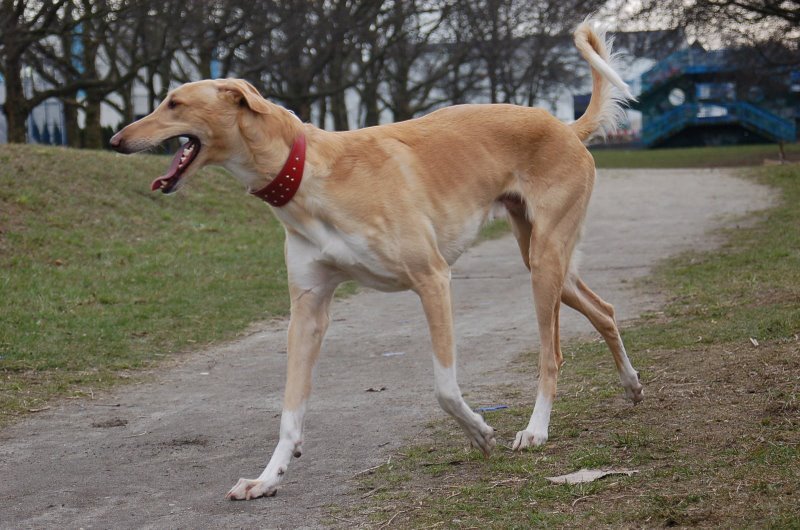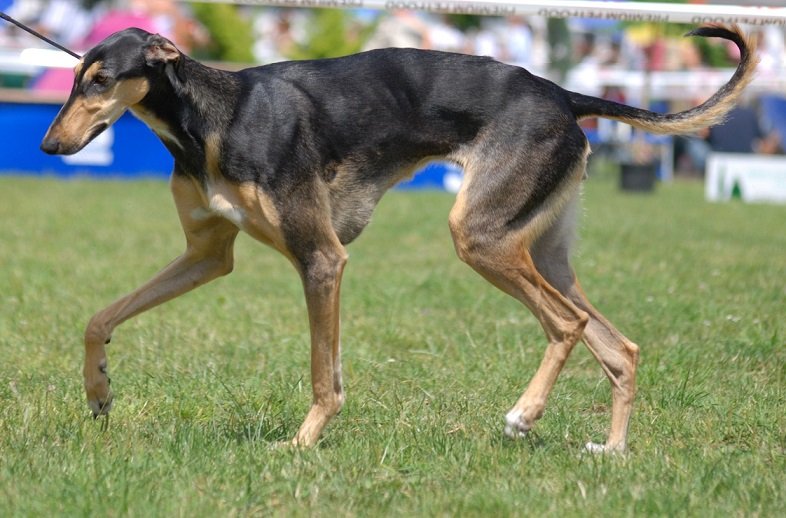Polish Greyhound is part of the sight-hound category of the dogs who used to hunt by seeing and chasing the prey. They are also known as Polish Sighthound or Chart Polski (in Polish).
They are large and active dogs who are territorial as well. While approved by Poland Kennel club, UKL, and FCI, they are not yet approved by the American kennel club.
Polish Greyhound at a glance
| Size | 28 to 31 inches |
| Weight | 60 to 80 pounds |
| Temperament | Energetic, Territorial and affectionate |
| Lifespan | 10 to 13 years |
| Price | $1000 – $1500 |
| Purpose | Watch dogs |
| Popularity | Low |
| Grooming | Low |
| Hypoallergenic | No |
Appearance
Body: Polish Greyhound are large dogs with a lean muscular body suitable for running fast and chasing the prey. They have a long muscular neck with a large deep chest.
Face: They have a long lean face with a long muzzle. Their nose color is dark generally black.
Eyes: They have relatively large almond shaped dark eyes, set in slanting.
Ears: These Polish dog’s ears are medium size that fall down to the eye level.
Tail: They have a long curvy tail.
Coat: These Polish dogs have a double coat. The coat is short haired and comes in varied colors.
Size: An adult Polish Greyhound size is around 28 to 31 inches tall and he can weigh approximately 60 to 80 pounds.
Lifespan: Their average lifespan is 10 to 13 years.
Often misled by the name greyhound, Polish greyhound is not directly related to Greyhounds.
Temperament of Chart Polski dogs
Territorial and Protective
Unlike other sighthounds, Chart Polski is territorial and protective. They are wary of strangers and do well as guard dogs.
Muscular and Agile
They have a body made for agility and running and need a lot of exercise and playtime to vent out their energy.
Affectionate
They are quite loving and affectionate to the owners.
Young children under supervision
They love their family including children but being large dogs who were originally bred for hunting, young children should be with them under adult supervision only.
Experienced Owners only
They are large dogs with a dominating appearance and need an owner who can take the position of the leader of the pack.
Not great with other dogs
Polish Greyhound dogs are aggressive to other dogs and pets. They can chase small pets and hurt them. Thus they should be avoided if you have other pets at home.
Not apartment friendly
These Polish dogs are large size who need a lot of playtime and exercise. They are not considered as Apartments friendly.
On Leash when outside
They are fast runners who can be aggressive and chase other dogs. It is a must that you keep them on a leash when you are outside.

Care
Nutrition
Polish Greyhound dogs are large dogs. They should be given 3 to 5 cups of dry dog food divided into two meals in a day based on how active the dog is.
We would recommend CANIDAE All Life Stages Premium Dry Dog Food. It has the protein and added nutrients like
- Probiotics added to every kibble after cooking to support healthy digestion
- Antioxidants to support a healthy immune system
- Omega 6 & 3 fatty acids to support beautiful skin and coat.
Exercise
Coming from the Sighthound family of dogs, this polish dog loves to run. He needs a lot of running and playtime for his exercise needs. He is best suitable for folks having a large fenced yard.
Grooming
Though Chart Polski has a short double coat, still they are easier to groom. Once in a week brushing is enough for keeping their coat clean and magnificent.
They do shed moderately and to control the amount of shedding, daily brushing is recommended.
We recommend Handson Pet grooming Gloves that can do the job for him.
Occasional bathing once every two or three months is good enough for keeping them clean and healthy.
You should also trim his nails once in a month so as to prevent nail split which could be quite painful.
Training
These Polish dogs are large dogs who are intelligent but can be obstinate as well. They are wary of strangers and have high recall so can chase small animals and hurt them.
We recommend that you do the obedience training and socialization for them since puppy age.
Health
They are generally healthy dogs but are prone to large dog diseases like below –
Cardiomyopathy – This is a medical condition in which the heart muscle degenerates and the heart becomes enlarged that can lead to congestive heart failure.
Bloating – Bloating is also known as gastric torsion. It is a situation when gas is formed causing the stomach to distend and twist on its axis.
The dog is unable to vomit the extra air. He comes into a shock and immediate medical assistance is required. This can be a life-threatening situation that may require surgery.
Hip dysplasia – This is a medical condition when the thigh bone doesn’t fit properly into the hip joint.
Pros and Cons
| Pros | Cons |
|---|---|
| Intelligent and Loyal | Can be aggressive to other dogs and pets |
| Highly active and energetic | Be cautious with young children |
| Low maintenance for grooming | Not apartment friendly |
| Good as Watchdog | Need a lot of time for exercise |
Origins
It is believed that they were originally bred in the 12th century for hunting wolves, deer, hare, and birds and were a favorite of Polish nobility.
Until world war 2, this was only a breed for rich but after the war, many Chart Polski were left homeless. Many middle and lower income class folks then took them to their homes.
Breed was almost extinct then but was rehabilitated in 1970’s by a few dog enthusiasts like Stanisław Czerniakowski.
Do you known or own a Polish Greyhound? Let us know your story in the comments below.

